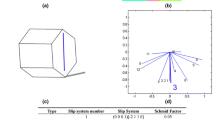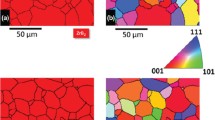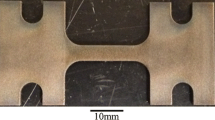Abstract
Understanding the deformation mechanisms present near grain boundaries in polycrystalline hexagonal alloys will aid in improving modeling methods. Ti-5Al-2.5Sn samples were tensile tested at 296 and 728 K, and slip behavior was assessed near grain boundaries. From the EBSD measurements of grain orientations, various metrics related to the slip systems, traces, residual Burgers vectors, and grain boundary misorientation were computed for boundaries showing evidence of slip transfer and boundaries showing no evidence of slip transfer. This work is compared to a similar study of an aluminum oligo-crystal to aid in understanding the differences in slip behavior near grain boundaries in HCP and FCC crystal structures.
Access provided by Autonomous University of Puebla. Download conference paper PDF
Similar content being viewed by others
Keywords
Introduction
The overarching goal of the research is to further understand the deformation mechanisms in titanium alloys, specifically Ti-5Al-2.5Sn (Ti525). Knowledge of the deformations mechanisms can aid in improving the modeling methods such as crystal plasticity finite element (CPFE) modeling, to enable more predictive ability to model heterogeneous strain near grain boundaries.
The slip transfer that will be discussed is where perfect slip transfer does not occur across the grain boundary, resulting in some residual Burgers vector (Δb) left in the grain boundary. The residual Burgers vector, Δb, is estimated by the dislocation reaction equation: \( \Delta b = \vec{b}_{1} - \vec{b}_{2} \). The geometric compatibility factor, m’, is used as a criterion to determine if slip transfer is likely to occur. An m’ value closer to 1 would imply that slip transfer is more likely to occur on the specified slip systems, as they would be nearly collinear, as opposed to a slip system pair that has lower m’ values. The Schmid factor is used as a metric to determine the most likely slip systems that are activated in the two neighboring grains when there is unidirectional stress.
The Ti-5-Al-2.5Sn (Ti525) alloy was provided by Pratt & Whitney, Rocketdyne. It was forged in the upper half of the α + β phase field. The material was then annealed at 1127 K for 1 h for recrystallization, followed directly by air cooling, followed by a vacuum annealing process at 1033 K for 4 h to reduce the hydrogen content. The samples examined were in situ tensile tested within the Tescan Mira3 SEM, with a displacement rate of 0.004 mm/s (approximate strain rate of 10−3 s−1). One sample was tested at 296 K and another at 728 K.
If there were correlated slip traces in one grain and a neighboring grain, a set of criteria were considered to determine if slip transfer accounted for the correlated slip traces. These criteria are: (1) Determination of probable slip systems would be consistent with observed slip traces. (2) A m’ value associated with the observed correlated slip systems is generally larger than 0.7. (3) The residual burgers vector (Δb) associated with the observed correlated slip systems is generally smaller than 0.5b. (4) The Schmid factor of each slip system is generally larger than 0.25. (5) The topography at the grain boundary is small indicating that the boundary does not lead to heterogenous strain on both sides. (6) The observed slip traces on each side have a topographical directional sense that implies that the slip planes are approximately parallel.
Results
Misorientation Angle Versus m’
Figure 1 shows the trend of the “slip transfer” and “no slip transfer” data for misorientation versus the geometric compatibility factor (m’). Below 20° misorientation angle in both the room temperature and high temperature sample, there is a trend of high m’ values that slopes downward as the misorientation angle increases.
m’ Versus Residual Burgers Vector (Δb)
The Luster-Morris parameter (m’) versus the residual Burgers vector (Δb) is plotted in Fig. 2. The black dotted lines are plotted such that the maximum number of “slip transfer” points are inside the box, and the maximum number of “no slip transfer” points are outside the box. 64 and 91% of the “slip transfer” points are located inside the black dashed, and 94 and 68% of the “no slip transfer” points are outside the dashed box for the room and high temperature samples, respectively. The high temperature data shows a much larger black dotted box compared to the room temperature data, and the relative percentages of the two populations inside and outside the box are reversed. The “slip transfer” data are clustered in the lower right-hand corner of the graph, i.e., at high m’ and low residual Burgers vector values. The “no slip transfer” points are spread out, and there are many points within the lower right box for the high temperature data. This indicates that slip transfer happens more frequently with lower m’ and higher residual Burger vectors in the high temperature sample.
Misorientation Angle Versus the Sum of the Schmid Factors
(m’(SFLG + SFRG)) is plotted against the misorientation angle in Fig. 3. The “no slip transfer” data have a larger spread of m’(SFLG+ SFRG), while the “slip transfer” data have a m’(SFLG+ SFRG) closer to 1 for both data sets. In the high temperature data set, there is a cluster of “slip transfer” points between 35° and 50° misorientation that has a m’(SFLG+ SFRG) value below 0.6. This cluster is not present in the room temperature data.
m’(SFLG+ SFRG) parameter versus misorientation angle for a the room temperature (296 K) and b the high temperature (728 K) sample. There is a decreasing trend in “slip transfer” data below 30° misorientation angle. The “no slip transfer” data are mostly present above 30° misorientation angle. (Color figure online)
Misorientation Angle Versus m’/Δb
Figure 4 shows the relationship between misorientation angle and m’/Δb. The purple lines are constructed to have maximum “slip transfer” points above, and maximum “no slip transfer” points below it. There is a decreasing m’/Δb trend for “slip transfer” data below the 30° misorientation angle for both samples. The high temperature data set is observed to have a stronger trend in this region, as the data is more closely packed. Above 30° misorientation angle, both “no slip transfer” and “slip transfer” data have a larger spread but there appears to be a threshold for the “slip transfer” data (above m’/Δb = 1), while the “no slip transfer” data are scattered over a wider range. Both the “no slip transfer” and “slip transfer” data for the room temperature sample has a larger spread compared to the high temperature data.
Discussion
This chapter will compare the results of the high temperature tensile-tested sample, to the room temperature tensile-tested sample. In addition, the results obtained in the Ti525 samples are compared to the results of “A criterion for slip transfer at grain boundaries in Al” by R. Alizadeh. Alizadeh performed an investigation in an aluminum oligo-crystal tensile sample tested at room temperature.
m’ Versus Residual Burgers Vector (Δb)
Figure 5 compares the m’ versus residual Burgers vector (Δb). The green box identifies the cluster boundary determined by Alizadeh. Alizadeh maximized the percentage of “slip transfer” points within the box and percentage of “no slip transfer” points outside the box. A comparison of Al maximized boundaries and titanium maximized boundaries are given in Table 1. The aluminum sample has a boundary of lower Δb and higher m’ values compared to the high temperature tensile-tested sample. In comparing the room temperature Ti525 sample and the room temperature aluminum sample, the boundaries are very similar. This shows the temperature dependence of the m’ versus Δb factors. Higher Δb values and lower m’ values enable slip transfer when the temperature in the material is hotter. In comparing the titanium room temperature sample to the titanium high temperature sample, more points with lower m’ values are observed.
Dislocation climb in titanium alloys is facilitated by higher temperatures. If dislocations can climb near the boundary to align themselves with a lower m’ geometry partner, then slip transfer is enabled under less favorable conditions. Higher diffusion rates enable recovery processes to take place near and within grain boundaries, so that residual Burgers vector debris is more easily absorbed.
The homologous temperatures of the two materials are given in Table 2. The RT Al and HT Ti525 homologous temperatures are similar to each other.
Given that the slip transfer behavior in aluminum and Ti525 are more similar to each other at room temperature, the effect of alloying elements and/or the much lower CRSS in pure aluminum may lead to less stress-assisted climb forces for a similarly high homologous temperature, such that the higher stresses in Ti525 facilitated climb more effectively than in Al. The stiffness normalized strength in Ti525 was 0.006 for the room temperature sample and 0.003 for the high temperature sample while it was 0.00036 in pure Al. The aluminum compensated strength is significantly lower than the Titanium alloy, due to the effects of alloying.
Misorientation Angle Versus m’
Figure 6 shows the misorientation angle versus m’ for both the titanium oligo-crystal and the aluminum alloy samples. The room temperature (296 K) Ti525 tensile sample (a) and the high temperature (728 K) Ti525 tensile sample (b) are overlaid with the shaded areas representing the locus of most of the points in the aluminum polycrystal. Since aluminum has a cubic structure with maximum disorientations of 63°, there is a much larger range of misorientation as well as m’ values for Ti525 slip transfer points. Alizadeh identified a threshold of about 20° that best separated the “slip transfer” and “no slip transfer” categories, which occurred in the middle of the “slip transfer” region (blue region). The titanium alloy shows similar behavior, but the threshold is not as distinct, as most observations are at misorientations larger than 20°. This disparity could arise from the fewer easy slip systems in hexagonal crystal structures that lead to more heterogeneous stress states in titanium. Another possibility is that the aluminum oligo-crystal grains have mostly free surfaces while the Ti525 sample is a polycrystal, where only one side of the grain has a free surface, which makes the stress state more complex.
Aluminum oligo-crystal “slip transfer” (blue shaded area) and “no slip transfer” (red shaded area) compared to data of the titanium polycrystal data for a the room temperature (296 K) and b the high temperature (728 K) sample. Titanium “slip transfer” and “no slip transfer” points do not follow as strict of a trend compared to the aluminum data. (Color figure online)
Unlike the titanium alloy, the aluminum oligo-crystal has a strong texture, so that most grains had a more similar stress state and strain response. With fewer easy slip systems available in the Ti525, slip may be required on slip systems that do not facilitate slip easily, leading to a wider variation in the local stress state, which would lead to more spread in the data. Furthermore, the “no slip transfer” points are not present in the room temperature titanium sample below ~30° misorientation, while in the aluminum and high temperature Ti525 data sets, they are present at misorientations as low as ~10° in Al and the high temperature Ti525 data. These differences imply that differences in crystal structure and geometrical limitations need to be considered.
Misorientation Angle Versus the Sum of Schmid Factors
Figure 7 shows comparison between the misorientation angle versus m’(SFLG+ SFRG) for the (a) room temperature and (b) high temperature Ti525 alloy. The green solid line represents the thresholds for aluminum, where “slip transfer” points was prevalent above the green line. The same process was done with the titanium data. The trends between the boundaries of the aluminum and titanium “slip transfer” data are significantly different, in that a shallow positive slope best separates prevalent “slip transfer” and “no slip transfer” populations, and the threshold is much lower threshold than that for Al. The boundaries for the high temperature and room temperature samples in the titanium alloy are very similar, but lower for high temperature data. This also indicates that a threshold for m’(SFLG+ SFRG) versus misorientation angle is heavily dependent on material and crystal structure. Clearly, the geometrical constraints for slip transfer are much smaller in the hexagonal crystal structure than in Al.
Misorientation angle versus m’(SFLG+ SFRG) for the a room temperature Ti525 and b the high temperature Ti525 sample. The aluminum boundaries represented by the green line show the difference between the aluminum data set which has a steep slope and the titanium data set which slope is flatter. (Color figure online)
Misorientation Angle Versus m’/Δb
Figure 8 presents the misorientation angle versus m’/Δb for (a) the room temperature and (b) the high temperature Ti525 sample. The shaded areas are approximate representations for misorientation angle versus m’/Δb for the aluminum oligo-crystal. The blue shaded region for the aluminum oligo-crystal “slip transfer” data and the blue cluster of data from the titanium alloy below 30° misorientation angle line up well, indicating a strong correlation between the two data sets in this range. The red shaded area representing the aluminum “no slip transfer” data expands greatly below m’/Δb = 1, as do the titanium “no slip transfer” data. The black rectangle represents the data bounds for the FCC aluminum data set. Figure 8 also shows that there are less geometrical constraints for slip transfer in the hexagonal Ti alloy than the aluminum FCC material. In comparing the 296–728 K Ti525 data, the boundary lines separating maximum “slip transfer” and “no slip transfer” are nearly the same, but the higher temperature has a slightly smaller slope indicating that temperature does not have a great effect on m’/Δb versus the misorientation angle.
Misorientation versus m’/Δb for a the room temperature (296 K) and b the high temperature (728 K) sample. The red shaded area represents the aluminum oligo-crystal “no slip transfer” data. The blue shaded area represents the aluminum oligo-crystal “slip transfer” data and line up with the slip transfer points in the Ti525 data. (Color figure online)
Summary and Conclusions
This paper describes the method and results of a study of Ti-5Al-2.5Sn deformation behavior focusing on slip transfer across grain boundaries at two different temperatures (296 and 728 K). The study investigates “slip transfer” conditions across grain boundaries. The results are compared to a similar study that was done with pure aluminum by R. Alizadeh. In comparing the titanium results to an aluminum sample, some trends are similar, such as favorable slip transfer of the same slip system family at low misorientations. Details associated with geometrical constraints of more slip systems in the hexagonal crystal structure, but few facile ones, versus face-centered cubic crystal structure in aluminum. These results show that slip transfer is much more commonly accomplished in the Ti-5Al-2.5Sn deformation in and room and to a greater extent at high temperatures, which provides a basis for installing slip transfer criteria into CPFE modeling of the alloy.
Conclusions
-
1.
“Slip transfer” data is more prevalent than “no slip transfer” data at misorientation angles <30°. At these low misorientation angles, slip traces are categorized as “slip transfer” more than being categorized as “no slip transfer” at both 296 and 728 K.
-
2.
There is a decreasing trend of m’ “slip transfer” traces with increasing misorientation below 20° for both Al and Ti525. Many “slip transfer” cases occur at high misorientations in titanium.
-
3.
Literature suggests that high m’ and low Δb enable slip transfer. This hypothesis was found true in Ti525. Room temperature Ti525 and room temperature aluminum show a similar behavior in m’ versus Δb.
-
4.
Considering both the Schmid factor versus m’, and m’ versus Δb, geometrical constraints for “slip transfer” in hexagonal crystal structure are smaller than FCC.
Author information
Authors and Affiliations
Corresponding author
Editor information
Editors and Affiliations
Rights and permissions
Copyright information
© 2021 The Minerals, Metals & Materials Society
About this paper
Cite this paper
Edge, C., Bieler, T.R. (2021). Analysis of Slip Transfer in Ti-5Al-2.5Sn (Wt%) at Two Temperatures in Comparison with Pure Aluminum. In: TMS 2021 150th Annual Meeting & Exhibition Supplemental Proceedings. The Minerals, Metals & Materials Series. Springer, Cham. https://doi.org/10.1007/978-3-030-65261-6_19
Download citation
DOI: https://doi.org/10.1007/978-3-030-65261-6_19
Published:
Publisher Name: Springer, Cham
Print ISBN: 978-3-030-65260-9
Online ISBN: 978-3-030-65261-6
eBook Packages: Chemistry and Materials ScienceChemistry and Material Science (R0)












